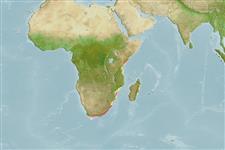>
Blenniiformes (Blennies) >
Clinidae (Clinids)
Etymology: Clinus: Greek, klinein, kline = sloping and bed, due to the four apophyses of sphenoid bone (Ref. 45335).
More on author: Smith.
Environment: milieu / climate zone / depth range / distribution range
Ecologia
marino; salmastro demersale. Subtropical
Western Indian Ocean: Inhambane, Mozambique to the Kei Mouth in South Africa.
Size / Peso / Age
Maturity: Lm ? range ? - ? cm
Max length : 16.0 cm TL maschio/sesso non determinato; (Ref. 5496)
Short description
Chiavi di identificazione | Morfologia | Morfometria
Spine dorsali (totale) : 27 - 31; Raggi dorsali molli (totale) : 4 - 6; Spine anali: 2; Raggi anali molli: 21 - 24. Color varies in olive, browns and reds with obscure crossbars; preserved specimens uniform buff in color (Ref. 5496).
Occurs in weedy tide pools and subtidal areas.
Life cycle and mating behavior
Maturities | Riproduzione | Spawnings | Egg(s) | Fecundities | Larve
Smith, M.M., 1986. Clinidae. p. 758-769. In M.M. Smith and P.C. Heemstra (eds.) Smiths' sea fishes. Springer-Verlag, Berlin. (Ref. 5496)
IUCN Red List Status (Ref. 130435)
Threat to humans
Harmless
Human uses
Strumenti
Special reports
Download XML
Fonti Internet
Estimates based on models
Preferred temperature (Ref.
123201): 21.3 - 27.9, mean 26.8 °C (based on 346 cells).
Phylogenetic diversity index (Ref.
82804): PD
50 = 0.5000 [Uniqueness, from 0.5 = low to 2.0 = high].
Bayesian length-weight: a=0.01096 (0.00423 - 0.02842), b=3.04 (2.82 - 3.26), in cm total length, based on LWR estimates for this (Sub)family-body shape (Ref.
93245).
Trophic level (Ref.
69278): 3.3 ±0.5 se; based on size and trophs of closest relatives
Resilienza (Ref.
120179): Alto, tempo minimo di raddoppiamento della popolazione meno di 15 mesi (Preliminary K or Fecundity.).
Fishing Vulnerability (Ref.
59153): Low vulnerability (10 of 100).
